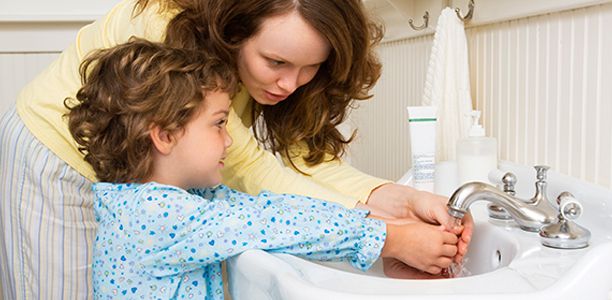Washing hands is one of the most important measures for preventing the spread of diseases. Lathering the hands with soap and rinsing them with running water is a simple method of removing germs before they spread. While children have a natural tendency to get their hands dirty, they usually need a bit of guidance from their parents to learn when they need to wash their hands and how to do it properly, so that the germs are washed away.
Children don’t instinctively wash their hands when they are dirty, so as a parent you’ll need to teach them how to do it. It’s also a good idea to talk to your children about why hand washing is important and when it should be done. Children develop the skills to wash and dry their hands by about two years of age.
Why is hand washing important?
Hand washing is important because it removes germs that can cause diseases from the hands and in doing so helps prevent the spread of those diseases.
Germs found on hands
The germs (also called microorganisms) found on your hands can be split into two types- resident and transient microorganisms. Resident microorganisms are germs which do not cause diseases in healthy people. They always live on your hands and cannot be removed by hand washing any more than the skin can be removed by hand washing.
Transient microorganisms, as the name suggests, come and go. They can be transferred onto your hands for example by coughing and sneezing, touching contaminated food or touching contaminated body fluids and substances for example faeces. Once germs have contaminated your hands they can cause infections.
Regardless of how your hands become contaminated, the best way to remove the transient germs is by washing with soap and water or decontaminating hands with an anti-microbial soap or an alcohol-based washing solution.
Preventing diseases from spreading
Hand washing is one of the most important things you and your children can do to prevent diseases from spreading. Not washing hands or not washing them properly is an underlying cause in about half of all outbreaks of food borne disease like diarrhoea around the world. In addition, about a quarter of respiratory infections like cold and flu are caused by unwashed or poorly washed hands.Not washing the hands also contributes to the spread of eye diseases such as trachoma and skin infections such as impetigo.
How often do adults and children wash their hands?
It’s difficult to produce statistics about how often people wash their hands throughout the day, because people tend to say they wash their hands more often than they actually do it. And even if they do wash their hands, they don’t do it properly.
For example, one New Zealand study found that 92% of women and 81% of men washed their hands after using the toilet but only 77% of women and 66% of men used soap. US research found that although 63% washed their hands (with just water) after using the toilet, only 2% did it properly using soap to lather their hands for 10 seconds or more.
How many infections can hand washing prevent?
Infectious diseases like diarrhoea and the flu which can be spread via unclean hands are significant health problems and responsible for millions of childhood illnesses and deaths around the world each year. Hand washing could prevent almost half of all childhood deaths associated with diarrhoea and a quarter of those associated with respiratory illnesses.
Worldwide, it is estimated that regular hand washing could save about one million lives every year, from diseases like diarrhoea and respiratory infections. As children are most likely to die from these infections, many of the lives saved would be children’s lives.
Teaching lifelong hand hygiene habits
Developing the skills to perform hygiene practices like hand washing independently is an important part of growing up. Like other skills learnt in childhood, learning to wash their hands properly early in life helps children develop lifelong hand hygiene practices.
What children can do for themselves obviously depends on their age. If you have a baby or toddler, you’ll need to wash their hands for them and until about three years of age, you’ll need to supervise and help out during hand washing. By about four years children have generally developed the skills to wash their hands all by themselves, as long as they can reach the tap and other equipment that they need. However, you will probably need to remind them to do it, for example before eating. By age five your children should be starting to remember when they need to wash their hands and you may just find that they take themselves off to the sink and do it without being asked.
Teaching children skills like hand washing takes focused attention from parents. But it’s worth the effort. Sooner or later they’ll be doing it independently and you’ll be able to use the time you used to spend helping them wash their hands on other things. Learning to wash their hands will help your child prevent diseases for the rest of their life. Teaching them to take care of their own bodies and health will also help build their confidence.

More information about handwashing techniques and activities for kids.
References
- South Australian Health Infection Prevention and Control. Hand Hygiene Guideline. 2010. (cited 19 January 2014). Available from: (URL Link)
- Vanderbilt University. Teaching your child to become independent with daily routines. 2010. (cited 19 January 2014). Available from: (URL Link)
- National Childcare Accreditation Council Inc. Supporting children’s hygiene skills. 2009. (cited 19 January 2014). Available from: (URL Link)
- Queensland Health. Physical and cognitive milestones. 2007. (cited 19 January 2014). Available from: (URL Link)
- Utah Department of Health. Hand Washing Information. 2005. (cited 19 January 2014). Available from: (URL Link)
- Condayan C, Hand Washing Fact Sheet. 2009. (cited 19 January 2014). Available from: (URL Link)
- Global Public Private Partnership for Washing Soap with Hands. Health Impact. 2013 (cited 19 January 2014). Available from: (URL Link)
- Garbutt C, Simmons G, Patrick D, et al. The public hand hygiene practices of New Zealanders: a national survey. J NZ Med Assoc. 2007. (Full Text)
- Drankiewicz D, Dundes L, Handwashing among female college students. Am J Infect Control. 2003; 31: 67-71. (Abstract)
- Judah G, Aunger R, Schmidt W. et al. Experimental pre-testing of handwashing interventions in a natural setting. Am J Pub Health. 2009; 99: S405-11. (Full Text)
- Virginia Early Childhood Development Alignment Program. Milestones of child development- A guide to young children’s learning and development from birth to kindergarten. 2009. (cited 26 July 2013). Available from: (URL Link)




 (8 votes, average: 3.75 out of 5)
(8 votes, average: 3.75 out of 5) 






